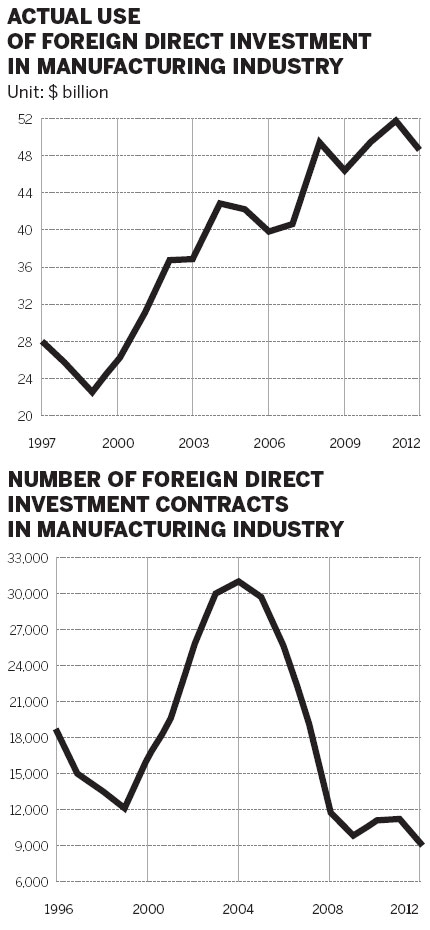Foreign companies eye new 'opening-up'
Updated: 2013-06-24 07:39
By Ding Qingfen and Liu Jie (China Daily)
|
||||||||
|
A model of Nanjing Software Park. Multinational companies are rushing to set up research and development centers in this kind of high-tech parks around China. Provided to China Daily |

High-end industry, research and development are biggest attraction
Over the past three decades, many foreign companies set up manufacturing facilities in China because of the country's low labor costs, turning the world's most populous nation into a global factory.
That is now looking like history.
As China pledges to turn itself into an innovative economy as part of a transformation in its economic growth model, encouraging foreign companies to invest in high-end industries, the world's second-largest economy is gearing up for a move into the upper end of the global chain.
For Alain Merieux, founder of the global in vitro diagnosis company BioMerieux, a very recent trip to China was fruitful.
As a member of the business delegation accompanying French President Francois Holland, who paid his first ever official visit to China in late April, the 85-year-old witnessed the signing of a cooperation agreement on biological sample extraction with Shanghai municipal government, announcing the French company would expand its research and development capability, as well as its manufacturing facility, in the city by the end of this year.
BioMerieux moved its Asia-Pacific headquarters to Shanghai in 2005 and established two R&D facilities in 2007 and 2010.
Merieux said in an interview with China Daily that what is motivating the French biomedical company to add more muscle to its R&D lies in the more innovation-friendly environment that China is committed to creating.
The innovation environment in China has improved and the nation is "paying much more attention to innovation and has issued a string of encouraging policies", said the founder. "It also created a sound environment for Sino-foreign cooperation, which was rare decades ago."
Merieux also cited figures. Because of its shrinking domestic market, "France is to consolidate diagnosis-related laboratories to 800 to 1,000 from the current 4,000 by 2016 but, in China, it will build and renovate 11,000.
"You can see the big difference and how China is passionate about innovation," said Merieux.
Because of the debt crisis in the eurozone and increasingly rising labor costs in China, the nation's foreign direct investment saw an annual drop of 3.7 percent in 2012, the first since 2009. The drop has aroused global concerns over whether China can continue to maintain pole position as the most appealing foreign investment destination among the emerging markets as it did for more than a decade.
China itself has few such worries. More than that, the nation is striving to go far beyond being a global manufacturing powerhouse, welcoming foreign businesses to get involved in more of the high-end industries to sharpen industrial competitiveness and implement an upgraded version of Chinese economics, something senior figures have repeatedly vowed to do.
Chinese Premier Li Keqiang has said on many occasions that China will advance development through opening-up in terms of R&D, new energy and services to foreign businesses.
Gao Hucheng, the minister of commerce, said recently that China will continue to welcome foreign investment, encouraging businesses to go into the sectors of high technology and R&D in the central and western parts of China in particular.
The new development has already started.
According to the Ministry of Commerce, in 2012, foreign investment flowing into China's high-end manufacturing industries of general equipment manufacturing and transportation equipment manufacturing saw fast growth of 31.8 and 17.2 percent from a year earlier, while the nation's foreign direct investment dropped by 3.7 percent year-on-year to $111.7 billion during the same period.
During the monthly news briefing in April, Shen Danyang, spokesman for the ministry, said the ups and downs of FDI figures do not mean much.
"It's the quality of the FDI that China really wants and cares about" and China is glad to see more foreign investment is flowing into high-end manufacturing and services, he said.
Aggressive companies
BioMerieux is not alone. Over the past year, more multinational high-tech companies and high-end manufacturers have been betting big on China, expanding their presence in Asia's largest economy. The multinational high-tech engineering group Sandvik AB is a case in point.
"Currently, our R&D in China is still about application and localization, so each business has its own team and focus," said ZZ Zhang, chief executive officer of Sandvik Greater China.
"But we are now considering whether to move some of our basic, early-stage and primary R&D capability to China."
The Sweden-based group has five units, including mining, machining solutions, materials technology, construction and venture capital. In China each business has its own R&D organization.
It's not only about R&D. Foreign businesses also increase their local presence through establishing high-end manufacturing facilities.
In March, Samsung Electronics announced it will spend $7 billion building a factory to make advanced gadgets of NAND flash technology, a type of digital memory widely used in smartphones and tablet computers. The operation will be the largest FDI measured by value made in China's western region.
"Many signals show China has realized the importance of enhancing cooperation with foreign companies through opening-up, especially in high-tech industries - and it is also advancing the initiatives," said Wang Zhile, president of the Beijing New Century Academy on Transnational Corporations and also senior researcher on FDI.
"Foreign companies should adjust their China strategy, integrating into the new development of China."
Abundant talents
Agreeing with Merieux, Zhang from Sandvik said the reason the Swedish company plans to expand its R&D team and capability in China could be partly attributed to the Chinese government's support for technology innovation and the strategic importance of the Chinese market to Sandvik.
China is the fourth-largest market for the company, accounting for 7 percent of the total external sales of the group. From 2002 to 2011, the average growth in annual sales of Sandvik China was more than 25 percent, with the total sales amounting to 7 billion yuan ($1.12 billion) in 2011.
Another consideration is the "rich talent resources, especially engineers", he said.
For Li Zhengqin, vice-president of Merck & Co and general manager of Merck Sharp & Dohme China R&D Center, China is "better than" other emerging markets for multinationals to enhance their R&D facilities.
"It's about government support and a rich talent pool. China's new leaders have decided to invest 800 million yuan in technology research this year and the fund will grow 20 percent annually in the coming years," said Li.
For the talent pool, there are "not only locally cultivated engineers but also overseas returnees, who have an international perspective and have accumulated experiences in other markets," he added.
MSD, the world's second-largest pharmaceutical company, announced at the end of 2011it would make a cumulative investment of $1.5 billion in R&D in China within five years.
So far, everything is "progressing smoothly", said Li.
Despite the slowdown, China's economy still enjoys fairly good growth worldwide and the new leadership is committed to delivering reforms and stimulating domestic consumption in the coming years. This has proved to be greatly attractive to foreign businesses, said experts.
"There are four factors that are important to them - and rapidly growing market consumption in China is the most important of all. They also look at reasonable labor, mature industrial chains and an improving business climate when they plan to expand," said Wang.
The government has set a 2013 economic growth target of 7.5 percent.
Chinese Premier Li Keqiang said in March that China is likely to import as much as $10 trillion in commodities and services in the next five years to boost domestic consumption.
In an e-mailed statement to China Daily, Japanese multinational industrial conglomerate Omron said China is a market on which the company will focus most in the coming decade thanks to the fast growth in consumption. Consequently it will strengthen its R&D efforts to develop more technologies and products tailored to the increasing local demand.
In addition to consolidating its current R&D strength, Omron plans to encourage its various units to increase its own R&D capabilities, it said.
"The Chinese market is rather large, with vast land and diversified demands. Even for some of our mature and key products, the needs are different in different areas so it's difficult for us to choose where to set up our R&D facilities," said Koji Doi, chairman and president of Omron (China) Co Ltd.
The multinationals are placing high expectations on China. "We expect annual growth in China to exceed 35 percent in the coming three years and we will have 100 more (R&D) partners in the next two years," said Merieux.
In 2012, BioMerieux China sales increased by more than 40 percent year-on-year to hit 100 million euros ($133 million).
China is currently the third-largest market for BioMerieux, after the United States and France. It is expected to be the second-largest within two years.
Merieux said he had previously never thought China would be one of the top three markets worldwide.
We have reasons to believe it will grow bigger, he said.
Innovative economy
As part of its 12th Five-Year Plan (2011-2015), China pledged to turn itself into an innovative economy and to expand domestic consumption.
During a meeting with executives from a host of multinationals attending the China Development Forum in March, Premier Li Keqiang pointed out that China will try to upgrade its economy and expand domestic consumption by opening up further to foreign businesses.
Li promised further opening-up in services and industries related to new energy, emphasizing the government will ensure foreign businesses get fair access to the market and a level playing field in terms of competition.
In late 2011, as part of the transformation of its economic growth model, China launched a new version of its guidelines for foreign industrial investment, encouraging foreign companies to add investment in high-end manufacturing, services and the high-tech sector in general.
The multinationals' expansion would turn into new growth engines for China and bring new technology as well, Wang Zhile said.
Merieux said his company has witnessed the development of the Chinese medical system and will continue to do so.
"China fell behind in terms of development. It was short of advanced technical methods to support scientific disease diagnosis and prevention. Now China has achieved cutting-edge technologies of a global standard," said the executive.
"But safer, more convenient and cheaper public health and basic medical services are still needed. That is what we can help and offer."
China is becoming the global R&D center for many foreign companies.
In late 2011, MSD started construction of its Asian R&D center in Beijing, which is still being developed. The center, which includes registration and clinical trials, R&D capability building and cooperation with local companies, universities and academic institutions, serves not only China but also global markets.
"We are trying to integrate China's R&D capability into our global network," said Dong Ruiping, senior vice-president of Merck Research Laboratories Emerging Markets.
Merieux said BioMerieux is implementing a "reverse" R&D strategy in China, so the new cooperation agreement and expansion of the Shanghai facilities are not only for local needs but also for its global network.
Contact the writers at dingqingfen@chinadaily.com.cn, liujie@chinadaily.com.cn



(China Daily USA 06/24/2013 page13)
Most Viewed
Editor's Picks

|

|

|

|

|

|
Today's Top News
H7N9 bird flu less deadly than H5N1
Snowden exposes more US hacking, then flies
China shares extend losses
Xi vows bigger stride in space exploration
Mandela's condition critical
Suspect in shooting spree detained
Mountaineers killed in Pakistan
Foreign firms eye new 'opening-up'
US Weekly

|

|
















